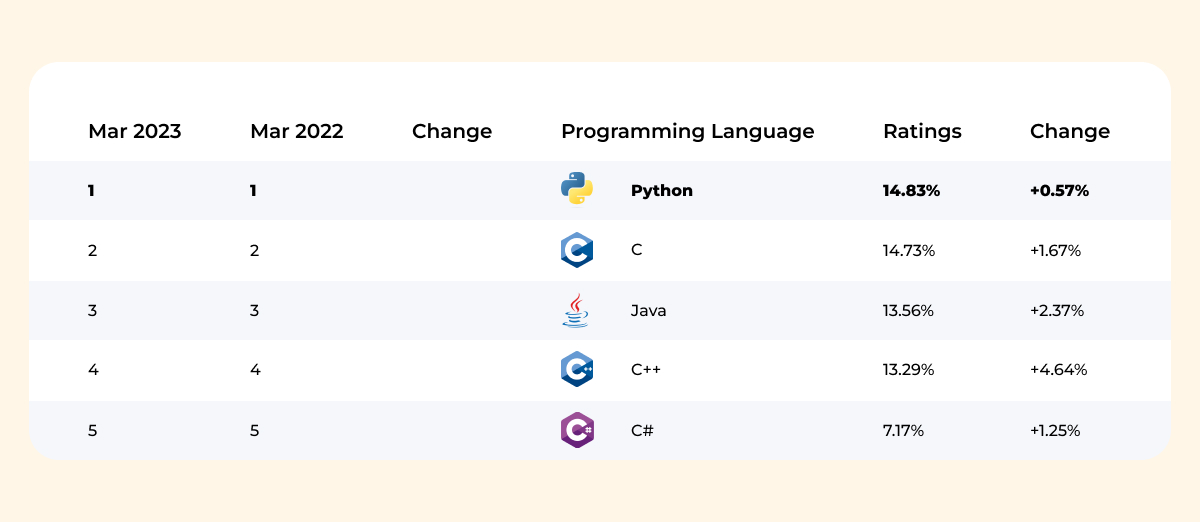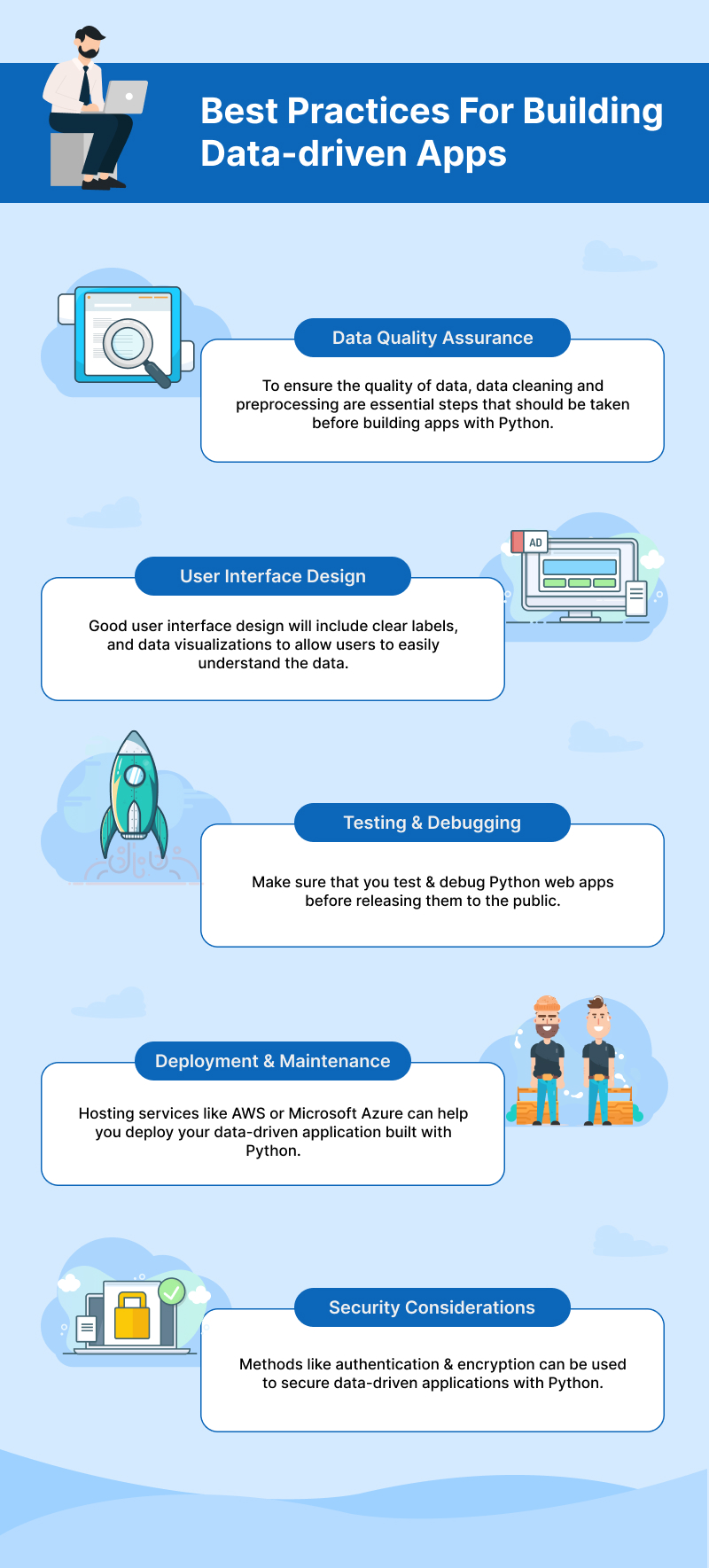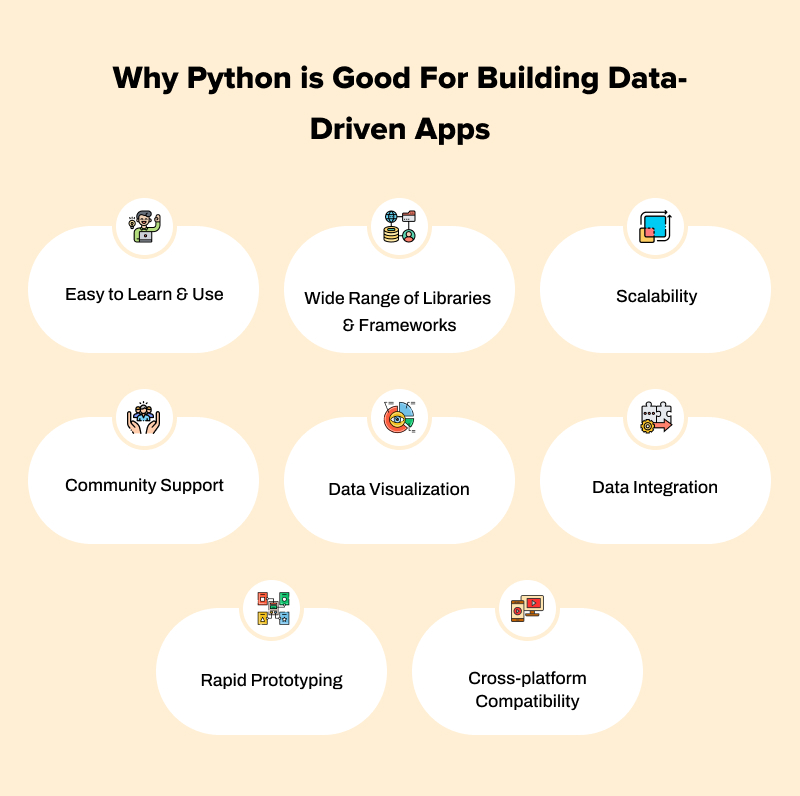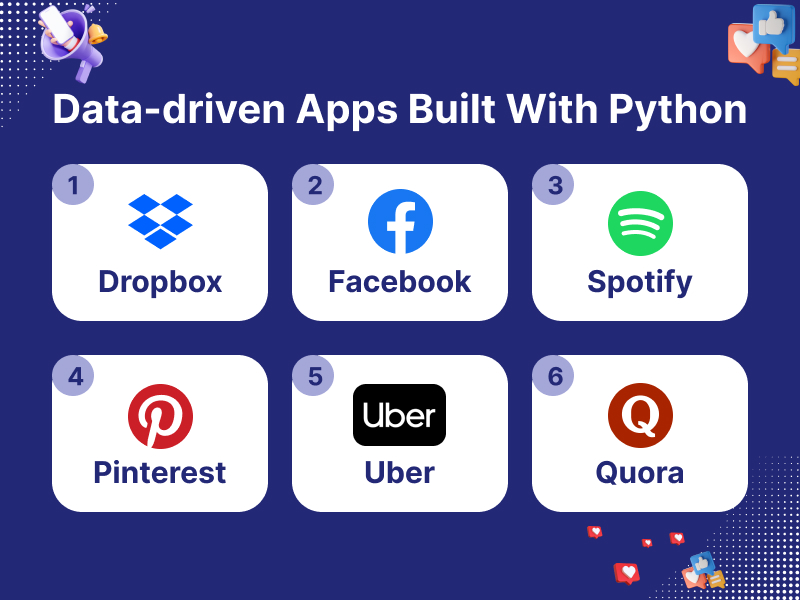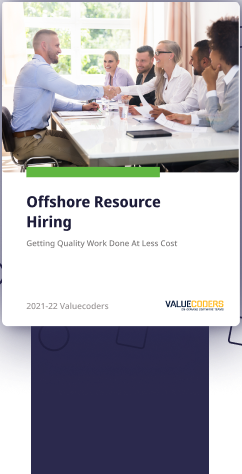Data-driven applications are becoming increasingly popular as businesses realize the significance of using data to drive their decisions. Python is one of the best languages to develop data science apps with minimal code and in a short time, typically a few hours. Based on its popularity, Python has ranked number one on the TIOBE index as one of the most prominent programming languages.
Source: TIOBE
Building apps with Python is easy and fast. We can use the top-ranked language for visualization & analysis to create robust machine-learning models. Here you will explore how to use Python to build data-driven applications for your business. You will also check out the tools & technologies used to create the app for a seamless user experience.
Let’s dive in!
Get free consultation and let us know your project idea to turn it into an amazing digital product.
Best Practices For Building Data-driven Apps
Now, let’s delve into some best practices for building data-driven applications. Building a data-driven application can be a complex task that requires meticulous planning and attention to detail. To simplify this, we are sharing some best practices you can use while creating your web app with Python.
- Data quality assurance: To start building apps with Python, you must finalize the type of application you plan to create. After deciding, ensure that you use high-quality data. For data quality assurance, cleaning and preprocessing are essential before developing apps with Python.
The data quality assurance process includes checking for missing values in the dataset, cleaning up messy data, and standardizing features across different datasets. Also, you should validate the dataset by running tests and looking at summary statistics such as means and standard deviations. Doing this will help the development team improve the accuracy of results & reduce errors when building apps with Python.
- User Interface Design: Once the data quality of your data science application is ensured, designing an intuitive user interface is critical when building an app with Python. A good user interface design comprises clear labels, data visualizations (charts or graphs) for effective understanding, and an intuitive navigation system. By creating a user-friendly interface, users will more likely find value in using the data science application and continue using it over time.
- Testing & Debugging: Next is a thorough testing & debugging of your Python web app before releasing. The reason is while developing applications for data science, it’s essential to manually test the functionality of the web app and ensure that all of its components work correctly. To ensure the efficiency of the project, you can either go for Python development services or custom application development services.
Automated testing tools like Selenium can check the performance of a Python web app against specific criteria, such as response times and CPU utilization. Hiring a dedicated software development team can give you expert guidance and help you avoid mistakes while building data science applications.
- Deployment & Maintenance: One must consider the deployment & maintenance of their app after completing the steps mentioned above. Deploy applications built with Python through hosting services like AWS or Microsoft Azure.
It’s highly recommended to hire skilled Python developers to work with hosting services & deployment processes.
- Security Considerations: Security is another crucial point when developing data-driven applications with Python. Businesses often store large amounts of sensitive data and require strict security protocols. When building an app, implement various security measures to ensure data safety and protect businesses from cyber-attacks.
For instance, one can implement authentication methods to verify that the right users access the application and use encryption to protect data in transit and storage. Also, set access controls to limit the types of operations performed within the application.
It’s wise to consult with eCommerce development services and have their help to implement the needed security protocols. With their assistance, you can be assured that your data-driven applications remain safe & reliable.
Also Read: How Python Is Best Fit For Artificial Intelligence In Web Development?
Python Libraries & Frameworks For Building Data-driven Apps 2023
Python is a top-ranked programming language excellent for custom application development because of its extensive libraries & frameworks.
If you plan to build a data-driven application using Python, several frameworks are available that make the development process more accessible and a lot simpler.
Here you can find some of the frameworks:
- Django: A high-level, open-source framework for rapid development & clean design, Django is suitable for creating complex web applications quickly. It also provides powerful ORM (Object Relational Mapper) tools.
- Flask: Next is Python Flask, which provides a lightweight framework for developing web applications faster and more efficiently. Flask has many features, such as URL routing, database support, template rendering, etc.
- Pyramid: It is an ideal framework for building Python web apps that need scaling. Pyramid is a scalable & flexible web framework designed for creating web applications of all sizes. It has tools for building web apps like routing systems, authentication systems, & templating engines.
- CherryPy: CherryPy is ideal for building small to medium-sized web applications. It is a minimalist & lightweight Python web framework with a modular design, allowing developers to add features as needed.
- TurboGears: It is a full-stack web framework with an ORM, templating engine, and support for multiple databases. It also has tools for managing authentication, caching, and more.
- Tornado: It is a high-performance web framework designed to develop real-time web apps. It also has tools for creating web applications comprising a non-blocking I/O system and a web server.
- Falcon: Falcon is a high-performance web framework that builds RESTful APIs. It’s lightweight, easy to use, and includes features like request validation, middleware, and more.
- FastAPI: A modern, high-performance web framework designed for building APIs. It offers automatic validation of request and response data, support for async programming, and more.
- Hug: It is a Python 3 framework for developing RESTful APIs. The lightweight of this framework makes it easy to use. It features automatic documentation generation, input/output validation, and more.
Get free consultation and let us know your project idea to turn it into an amazing digital product.
Now let’s have a quick look at Python’s rich ecosystem of libraries that supports in development applications of data science.
-
NumPy
In Python, NumPY is a fundamental library for scientific computing often used for data manipulation and analysis. It supports large, multi-dimensional arrays & matrices and an extensive collection of high-level mathematical functions.
-
Pandas
Pandas is often used for data exploration and preparation. It is a popular library for data manipulation & analysis. It supports working with tabular data, comprising importing, cleaning, filtering, transforming, and merging data.
-
Matplotlib
The next Python library on the list is Matplotlib, often used for visualizing data and communicating results. It supports creating a wide range of static and interactive plots, including scatter plots, line plots, bar plots, histograms, and more.
-
Seaborn
Seaborn is a higher-level data visualization library in Python, built on top of Matplotlib. We use it for developing publication-quality graphics and visualizing relationships between variables.
It supports building more complex & sophisticated visualizations, including heatmaps, pair plots, and violin plots.
-
BeautifulSoup
For data-driven apps, BeautifulSoup can scrape data from websites and integrate it into databases or other systems. It can benefit apps requiring real-time updates, like stock tickers or weather apps. If you want to ensure the utilization of this library, consider hiring dedicated software development teams and always stay up-to-date with the latest technology.
-
Scikit-learn
Used for building predictive models and making data-driven decisions, Scikit-learn is a widespread library for machine learning in Python. We often use this library to create predictive models and make data-driven decisions.
It supports various machine learning algorithms, such as classification, regression, clustering, and dimensionality reduction.
- TensorFlow
Another popular open-source library used for data science, especially for Machine Learning & Artificial Learning, is TensorFlow. The library has tools & resources for developing and training many neural networks, including deep learning models. Many companies prefer to hire Python developers with experience in machine learning and data science to get help with TensorFlow.
-
Keras
Next is Keras, a high-level library for building neural networks. It’s built on top of TensorFlow and provides a simple API for building complex models. It’s an excellent library for beginners to deep learning. The sound Python library supports neural networks, including convolutional neural networks (CNNs) and recurrent neural networks (RNNs).
-
Pygame
Pygame is a Python library commonly used for game development. While it may not have direct applications in data-driven apps, it is still a valuable tool for developers who want to create engaging and interactive user interfaces. Data-driven applications may benefit from integrating game elements or gamification to enhance user engagement and motivation.
Get free consultation and let us know your project idea to turn it into an amazing digital product.
Examples of Data-driven Apps Built With Python
Custom application development services utilizing Python can help organizations create powerful data-driven applications. Python web apps are one of the best ways to leverage the language’s unique features & capabilities to generate valuable insights from data. One can create many different types of apps with Python, like:
- Web Analytics: Analyzing user behavior on web applications and websites with Python to identify trends and usage patterns.
Examples: Google Analytics, Piwik, Matomo & Open Web Analytics.
- Business Intelligence: Aggregating, organizing, and analyzing large amounts of business data to uncover trends, insights, and opportunities for growth.
Examples: Apache Superset, Redash, and Metabase.
- Predictive Analytics: Utilizing predictive algorithms to forecast future outcomes based on past events and data points.
Examples: Zillow, UPS, and Uber.
- AI-Powered Applications: Building applications that use artificial intelligence and machine learning to automate decision-making processes.
Examples: Siri Voice Assistant (by Apple) and DeepDream.
- Database Applications: Develop custom applications to query databases and extract meaningful information.
Examples: YouTube, Reddit, and Dropbox.
- Customer Relationship Management (CRM) Systems: Automating customer service tasks by building apps that can integrate with CRMs.
Examples: ZOHO & Fresh Sales.
- Fraud Detection App: Using web apps with Python to detect any suspicious activity or unusual transactions made through online banking or e-commerce sites.
Examples: PayPal, Kount, and IBM Fraud and Financial Crimes Management.
Today, Python is an invaluable tool for data science, and its popularity continues to grow in business intelligence & analytics solutions. Python web apps provide robust functionality for organizations to gain insights from their data and make more informed decisions.
Conclusion
To conclude, Python is an excellent language for building data-driven apps. You can create efficient applications without complications with the correct libraries and frameworks. If you are well-versed in building a data-driven app, you can hire developers to help you with your project.
ValueCoders is one of the leading IT companies in the industry, having 18 years of extensive experience. Whether you need to build a custom CRM, an e-commerce platform, or a data analytics tool, ValueCoders can help.
We use agile development methodologies to deliver high-quality software quickly and efficiently. You can find our success stories of how we helped our clients meet their project requirements. By reading these stories, you can gain insight into our approach to solving challenges and delivering high-quality software.


